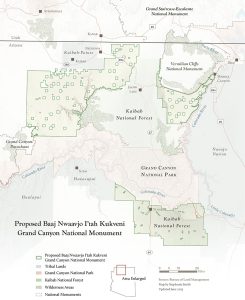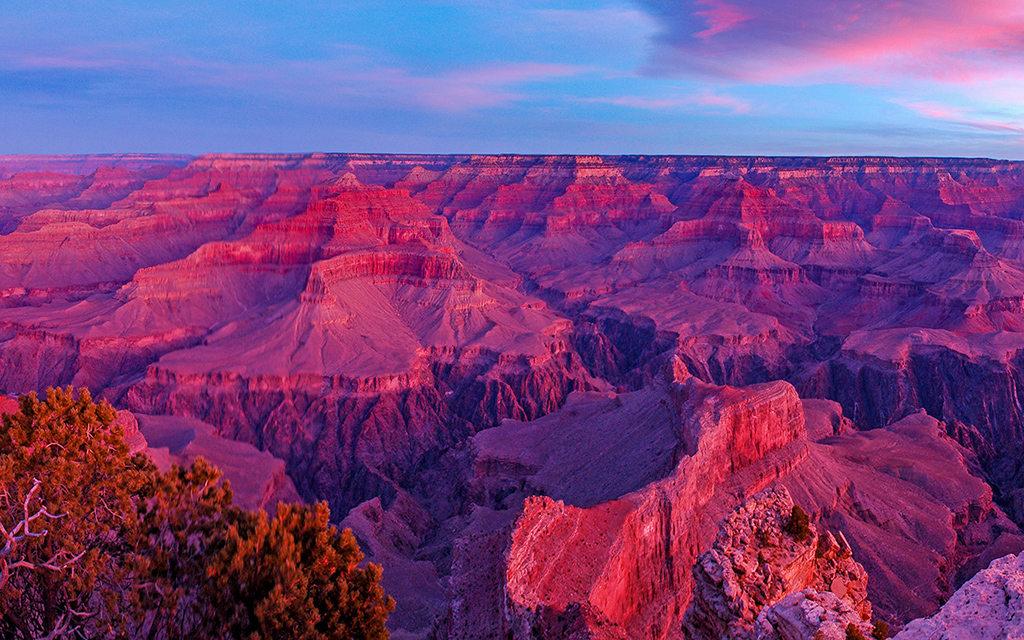FLAGSTAFF – Dozens of community members, tribal leaders and state officials gathered in Flagstaff on Tuesday to show their support for a proposed national monument around the Grand Canyon, saying the designation could protect natural and cultural resources.
The Bureau of Land Management and the U.S. Forest Service, which would manage the monument, hosted its first meeting to listen and gather public opinion on the proposal.
“I have one mouth and two ears. I plan to use them accordingly because we really, really do want to hear from you,” Homer Wilkes, under secretary for Natural Resources and Environment at the U.S. Department of Agriculture, told the crowd.

The proposed Baaj Nwaavjo I’tah Kukveni Grand Canyon National Monument would include more than 1.1 million acres in three areas of land adjacent to Grand Canyon National Park. (Map courtesy of Grand Canyon Trust)
The proposal asks President Joe Biden to designate more than 1.1 million acres as a national monument under the Antiquities Act of 1906, which allows presidents to set aside lands to protect cultural or natural resources.
The proposed Baaj Nwaavjo I’tah Kukveni Grand Canyon National Monument would include three areas of federal public land adjacent to Grand Canyon National Park and would prevent any further uranium mining in the protected area.
Several tribes in the Grand Canyon Tribal Coalition have ancestral ties to the canyon and honor it as a sacred place with natural landmarks and cultural ties. The coalition consists of 12 tribes and is leading the proposal for a new monument.
Tribal members expressed concern for plants, wildlife and water impacted by uranium mining.
“We cannot continue to scar Mother Earth,” Havasupai Vice Chairman Edmond Tilousi said. “The threat of contaminating our water is real and current. The pure water that flows through Havasupai Village is under constant attack by uranium mining.”
Tilousi said protecting the land is his duty to his children and future generations. He also mentioned that once Colorado River water is “dirtied by the mining of uranium, it will never be the same again.”
There are 598 active mining claims in the proposed monument area and one active uranium mine in a meadow below Red Butte Mountain and roughly 10 miles from the rim of the Grand Canyon, according to Keep It Grand AZ, which has a petition to support the monument.
Nearly 200 people showed up at Tuesday’s gathering in a show of support. Many people wore matching blue T-shirts that read “Baaj Nwaavjo I’tah Kukveni Grand Canyon National Monument.” Other people stood outside with signs asking for protection of the land.

Many people wore matching blue T-shirts that read “Baaj Nwaavjo I’tah Kukveni Grand Canyon National Monument ” to a public meeting to discuss the proposed national monument near the Grand Canyon. (Photo by Ashley Lay/Cronkite News)
However, critics who oppose the creation of the national monument said mining for uranium helps the economy.
“The move represents the Biden administration’s latest massive land grab and would be devastating to Mohave County,” said Penny Pew, a representative of Congressman Paul Gosar, R-Bullhead City. “The proposal was never coordinated with Mohave County officials, whose community will be permanently changed by this designation.”
The crowd loudly booed the statement.
In April, Mohave County Supervisor Buster Johnson told Cronkite News that uranium mining could be worth billions of dollars to the region’s economy, and historically has kept communities afloat.
“In the mining industry, they pay well. We’ve had some communities that, when they put the moratorium in, the men had to leave,” Johnson said. “The families deteriorated because the men weren’t around … schools closed. Jobs just aren’t there and communities went under.”
Also on Tuesday, Arizona Sens. Mark Kelly and Kyrsten Sinema and Congressman Raúl Grijalva released an announcement saying they introduced the Baaj Nwaavjo I’tah Kukveni Grand Canyon National Monument Act. The legislation outlines details and “directs the specifics of the formation and management” of the monument, according to a news release. The bill was not available by the time of publication.
Biden recently created two national monuments under the Antiquities Act of 1906. The Avi Kwa Ame National Monument is located in southern Nevada. The Castner Range National Monument is in northern El Paso, Texas.
In its proposal, the Grand Canyon Tribal Coalition outlined that visitors would still be able to continue to hike, bike, camp and enjoy the landscape within the monument.
Ben Stewart, who was at the meeting on Sinema’s behalf, told the crowd the next step would be to establish national funding for the monument.


